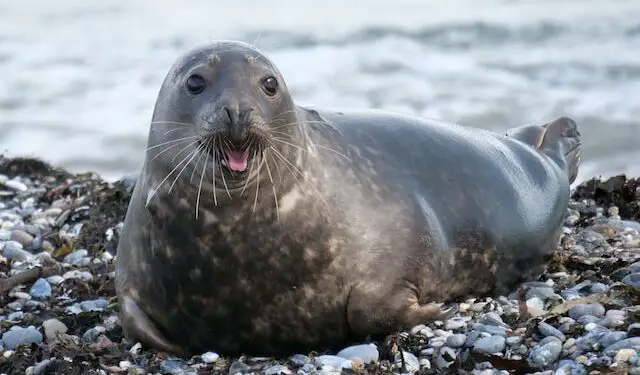What Color Is Seal
Seals, the charming marine mammals that inhabit marine life, have for ages captured our imagination. While lying in sun-soaked rocks, effortlessly gliding across frozen waters, or jolly bobbing in the ocean, seals have a particular spot in the hearts of nature lovers and animal lovers. Yet one straightforward yet elusive question that continues to spark our interest: What color is the seal’s color?
This question has caused many to imagine images of snow-white, pristine creatures enjoying the Arctic’s frozen expanse. However, when we dig deep into the seal world, we realize that their color is a complex tapestry created by nature. From the Arctic’s cold waters to the warm shores of the tropical islands, seals show amazing arrays of colors and patterns that challenge the stereotype of the “white seal.”
We set out on a journey into the mysterious world of seal coloring. Together, we’ll uncover the mystery of how seals appear in a variety of shades, as well as the causes that determine their color and the remarkable ability to change the colors of these marine wonders. Be prepared to be amazed by the dazzling array of colors that grace the seals that inhabit our oceans. We explore the depths of their world, revealing the secrets behind their captivating palette.
The Diversity Of Seal Species

Seals comprise a variety of marine mammal species, each having distinct characteristics and adaptions. Although they have a common ancestry and are part of an identical biological group, Phocidae, there’s a diverse array of species in this group, each with distinct characteristics, habitat preferences, and, of course, their colors.
1. Introduction to various species of seals
- Begin by explaining that seals aren’t a universal class; there are a variety of species.
- It is important to note that seals are split into two different subfamilies: the real seals (Phocinae) and the seals with eareds (Otariidae).
- Give a rough estimate of the seal species within each subfamily.
2. Color variations within seal species
- Discuss that one that is the most engaging features in seal variety is their vast variety of colors.
- It is important to note that colors for seals can differ from stark white to deep brown shades or gray. Some seal colors can even be black.
- It is important to note that these colors serve different purposes, including camouflage, thermoregulation, or signaling.
3. A few examples of the common seal species, as well as their colors.
- Give particular examples of species that are seals found in the two subfamilies, as well as describing their usual coloration.
- Include common species such as the harbor seal, harp seal seal, Weddell seal, and the elephant seal.
- Include any distinctive features or traits of the species you are describing that have to do with their coloring.
How Do You Determine The Color Seal
Seals may come in different shades, based on species. The most common colors for seals are:
- Gray: Gray seals are the most popular kind of seal and are located throughout areas such as the North Atlantic and North Pacific Oceans. They typically are brown or gray and have lighter undersides.
- harbor seals: Harbor seals can be seen in the waters of coastal waters all over the globe. They’re typically gray or brown in appearance and have patches of yellow or white.
- Leopard seals: Leopard seals can be found within the Southern Ocean around Antarctica. They’re typically brown or gray in color with leopard-like spots.
- Weddell seals: Weddell seals are located within the Weddell Sea in the vicinity of Antarctica. They’re typically darker gray, or even black hue.
- The elephant seal: They are by far the largest species of seal and are found in both the North Pacific and Southern Oceans. They’re typically brown or gray in color, and males have a huge proboscis (trunk).
The Myth Of White Seals

The sight of a flawless snow-white seal sitting on an iceberg in the Arctic is undoubtedly captivating. However, this iconic image has created a common myth that seals all share the same whiteness. In this article we’ll explore what is known as the white seal myth, and discover details about this enthralling image.
1. Debunking the myth of sealings all being white
- Begin by acknowledging the widespreadness of the myth and the source of it.
- Give evidence that there are different types of seals by describing different species of seals with different shades.
- The misconceptions that this can create cause confusion about the nature of marine mammal.
2. The reasons the reasons why white seals are frequently linked to seals
- Find out the causes that seals are associated with whiteness.
- Examine the role played by popular media literature, popular culture, and the history of this myth.
- Consider the way that white seals in the Arctic environment have become the symbol of seals in general.
3. Discussion on seal adaptations and camouflage
- Define how the coloration of seals, specifically white seals, is an adaptation for the survival.
- Discuss ways that white fur could help conceal the snowy Arctic landscapes.
- Also, mention other color-related changes in seals, for example mottled patterns or countershading.
Natural Colors Of Seals
Seals, as with other animals in animals, show an astonishing array of natural shades. From the stunning clear whites that are characteristic of Arctic seals to the earthy hues of species that live in the coastal zone, Seals’ coloration is an intricate interplay of the environment, biology, and evolution.
1. A look at the most predominant colors used by seals
- Offer a brief overview of the most popular colors used in seals.
- Use shades such as brown, white, gray and black.
- Explain that the colors serve a specific purpose in the life of seals.
2. Factors that affect the colouration of seals
- Examine the many elements that influence the seal’s color.
- Examine the role of genetics in determining skin and fur color.
- Define the ways that environmental factors, such as diet and habitat, may affect color.
- Be aware of the effects of sex, age, or even the effects of seasonal changes on a seal’s color.
3. In-depth descriptions of the color of seal species
- Offer more information in depth about the colors of specific seal species.
- Use examples from various areas and different environments.
- Make note of any noteworthy differences or color changes in these species.
Conclusion
As we conclude the book in our investigation of the fascinating world of seal coloring, we’ve explored a world of color as well as adaptability and wonder. From the myths about white seals to the intricate nature of natural colors that are influenced by the environment and genetics, We’ve discovered the truth about the color of an actual seal.
In our attempt to answer the elusively straightforward question, “What color is a seal?” We’ve found that seals aren’t bound by one hue or a fixed palette. They have a variety of colors that encompass the spectrum of nature. From the most pure whites of Arctic residents, hiding in icy landscapes, to the greys and earthy browns of coastal residents, every shade is a tale to tell.
The color of seals’ skin isn’t just an aesthetic feature and is a proof of the inventiveness of evolution. It’s an instrument for survival that aids with everything from temperature regulation to predator escape. It’s a form of communication that allows seals to negotiate the maze of their daily lives.
While we look at the array of colors found in the marine mammal species, we should think about the importance of conserving the habitats they inhabit and ensuring their populations. Seals, in all of their stunning hues, play a crucial part to maintain the balance between our oceans. Our duty as stewards of our Earth will be to make sure that the next generation will be able to continue to admire the stunning colours of these mysterious creatures.
To conclude this, the next time you see a seal, whether on the icy coastlines of the Arctic or on the sun-kissed shores of an island far away, Remember that its coloring is a marvel of nature, a testimony to the amazing power of evolution and adaptation. The question of what the color of a seal’s color is unlikely to be answered with a single answer; however, the quest to discover its secrets will reveal the incredible beauty of nature.
When we leave as we part ways, may our love of seals as well as their amazing diversity grow and let us always try to know more about the intricate tangle of life we live in.
















